EVERY DOG STORY ends the same way. (Spoiler alert: The dog doesn’t make it.) So why do we do it? Why do we intentionally introduce heartache into our life when we introduce a puppy into our home?
The easy answer is that the rewards—in companionship and hunting success with a canine partner—far outweigh the regret. Besides, if you are a dog person, not having a dog in your life is unthinkable, even though you have a pretty good idea of what will happen 12 to 14 years into the relationship.
I suppose I knew how Willow’s time with me and my family would end when she joined us as a pup. But those early days seemed blissfully endless. My kids were young, and they grew up with a puppy who was polite, obedient, intense in the field, and alternately frolicky and floppy in the house.
Once, my young son asked why Willow was so well-behaved. “Because she has a black mouth,” I answered blithely, without thinking about the implications. “All good dogs have black mouths.”
Then, as he spent the next months inspecting the mouth of every strange dog he encountered, I had to back off my pronouncement lest he get bit by a bad dog with a black mouth.
Willow grew into our family, becoming a talented bird hunter and a gentle presence in our lives. She would happily hunt with anyone, and did—accompanying my kids and scores of my friends to their first roosters and honkers. She hunted with senators and neighbors, pointers and setters, and plenty of fellow retrievers. She started to slow down a couple of years ago, but she responded by hunting smarter. She knew where birds would hold, and she’d dismiss marginal cover in favor of spending her time in these prime spots. And more often than not, her efforts produced a bird, or three.
For the past year, I’ve been wondering how Willow’s end would come. I expected it would arrive at the end of a veterinarian’s needle, and I dreaded the decision that would be mine to make: When is it finally time? What if I wait too long? Our final hunt (see “The Slough,” below) decided the matter for me, and as hard as it was, it was a relief, too. She died doing what she was meant to do. How many of us have wished for the same mercy?
Months on, I still wake up expecting Willow to be there by my bed, staring at my closed eyes and waiting for me to rouse. But we have a new puppy in the house. She’s a yellow Lab—just like Willow—and she’s birdy, mischievous, promising, impulsive. Her name is Nellie. And her mouth is pink. —Andrew McKean, August 2017

The Underdog
The runtiest of runts makes a heroic big-water retrieve / Tom Dokken, as told to Tony Peterson
There was only one female chocolate Lab in the small litter of six pups, and she was a runt. But not just any runt. She was the weakest runt I’ve ever seen. Not only was she about three-quarters the size of the other pups, she also had an underdeveloped back leg. But my wife, Tina, wanted her anyway. I was sure that even if the little runt survived, she wasn’t going to be a hunting dog. The decision, however, wasn’t mine to make. We named her Sage.
The other puppies bullied Sage, so we pulled her from the litter and bottle-fed her. With special care and attention, Sage survived, and soon it was time to start training.
Training any puppy is a gentle process. With Sage, it required all of the patience we could muster. It took her a year to get through the training that most of our dogs accomplish in months. But slowly her leg healed, and we coaxed her out of her shell.
Against all odds, Sage went from being the weakest puppy I’d handled in decades of dog training to an all-out bird-hunting machine. I have a lot of good memories of Sage, but one stands out as the greatest big-water retrieve I’ve ever witnessed.
Tina and I were hunting a 2,000-acre lake in South Dakota during the late season. It was chilly (probably in the mid-30s), and the wind was whipping at 35 mph from the north. The main part of the lake was rolling with 3-foot whitecaps, so we set up in a small bay.
Before long, Tina shot a drake wigeon and she sent Sage out for what we thought would be a routine retrieve. But when Sage was just about to reach the duck, the drake sprang to life. Sage was too close for us to swat the duck, so we just watched as the drake swam out and then dove. He popped up farther away, and then he dove again. And again. The crippled drake led Sage out of the bay and into the big rollers on the main lake. We could see Sage for a second through the whitecaps and then she’d disappear behind the crest of another wave.
At that point Sage was a few hundred yards out, with the wind blowing her and the duck even farther to the middle of the lake. She couldn’t hear our whistles over the wind, and our concern switched from losing the duck to possibly losing our dog. I took off running in my chest waders for our boat, which was a few hundred yards away. But when I reached the boat, I heard Tina yelling and saw her waving wildly at me from back in the blind. I looked way out into that gray, rolling water to see the white belly of a wigeon in Sage’s mouth as she paddled back toward us against the chop. Somehow I had underestimated Sage yet again.
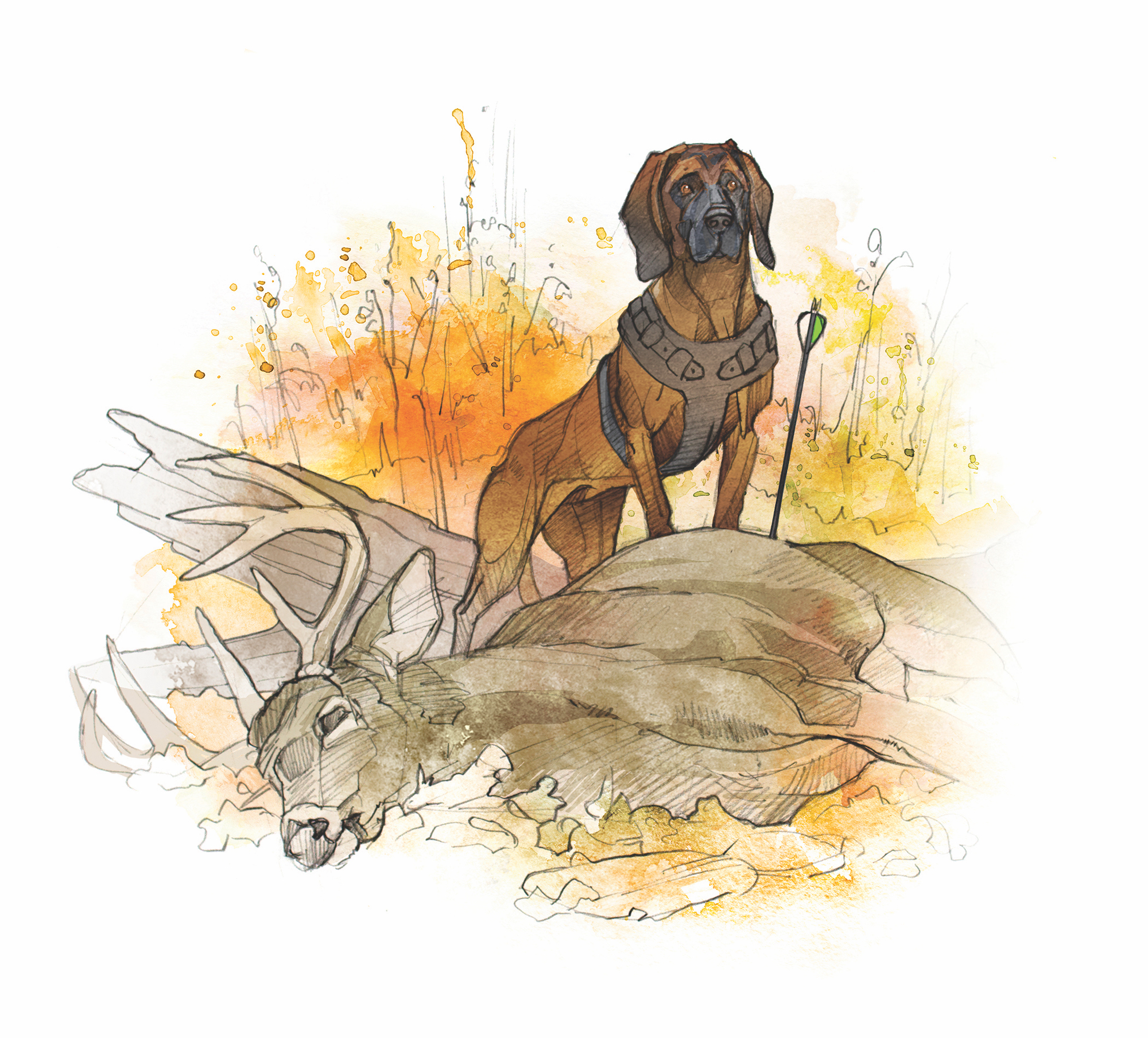
Cold Case
A veteran blood-tracking hound goes to work / By Alex Robinson
By the time Sean Timmens got his Bavarian mountain hound, Kieler, to the hit site, it had been 41 hours since the bowhunter had put an arrow in the buck.
At six years old, the hound was a veteran tracker who had successfully recovered more than 100 deer, but everything was working against him in this case. The shooter, Wisconsin bowhunter Justin Peak, had arrowed a nice buck during the afternoon of November 8. Peak tried to blood-trail the deer that evening but called it off later that night. The next morning, he went back with buddies and they searched for seven hours, running extensive grids across the property. Then they called Timmens, who runs Kieler after mortally wounded deer for $100 a pop.
This was a worst-case scenario for a blood-tracking dog. Generally, 48 hours is the maximum amount of time in which a dog can pick up a scent trail, Timmens says. And the hunters had tromped all over the property, unknowingly spreading tiny blood spores and scent from the deer’s trail to the vegetation around it.
But if there was any dog in the area that could find the buck, it was Kieler. Timmens, a veteran bird dog trainer, got the hound from Poland as a puppy, specifically to be a blood-tracker. Right away he was amazed by Kieler’s combination of easy-going personality and impressive athletic ability.
“He’s the most laid-back people dog I’ve ever had,” Timmens says. “But, he’s also 52 pounds of pure muscle and surprisingly agile. Out in the yard, he outruns my shorthairs.”
Kieler wears a harness that attaches to a 30-foot lead that Timmens holds as they work through the woods. When Timmens gets to a hit site, he gives Kieler a single command: “Let’s go to work.”
When he’s hot on a track, Kieler keeps hard, steady pressure on the lead, his nose vacuums the ground, and he snorts the whole way like a pig.
So when Kieler pulled Timmens from the hit site down a steep ridge, through a mixed hardwoods, and then toward a big draw, keeping his nose to the ground the entire time, Timmens knew his dog was nailing the track. Instead of going up the draw, Kieler veered right and headed into a thicket of chest-high briars and honeysuckle. The hound disappeared into the tangle, and seconds later Timmens could hear him thrashing around and chewing the dead buck’s hind legs.
They had traveled 600 yards and found the buck in just 15 minutes.
“I called back to the hunter, who was about 20 yards behind us: ‘You want to see your buck?’ ” Timmens says. “And he was just in total awe.”
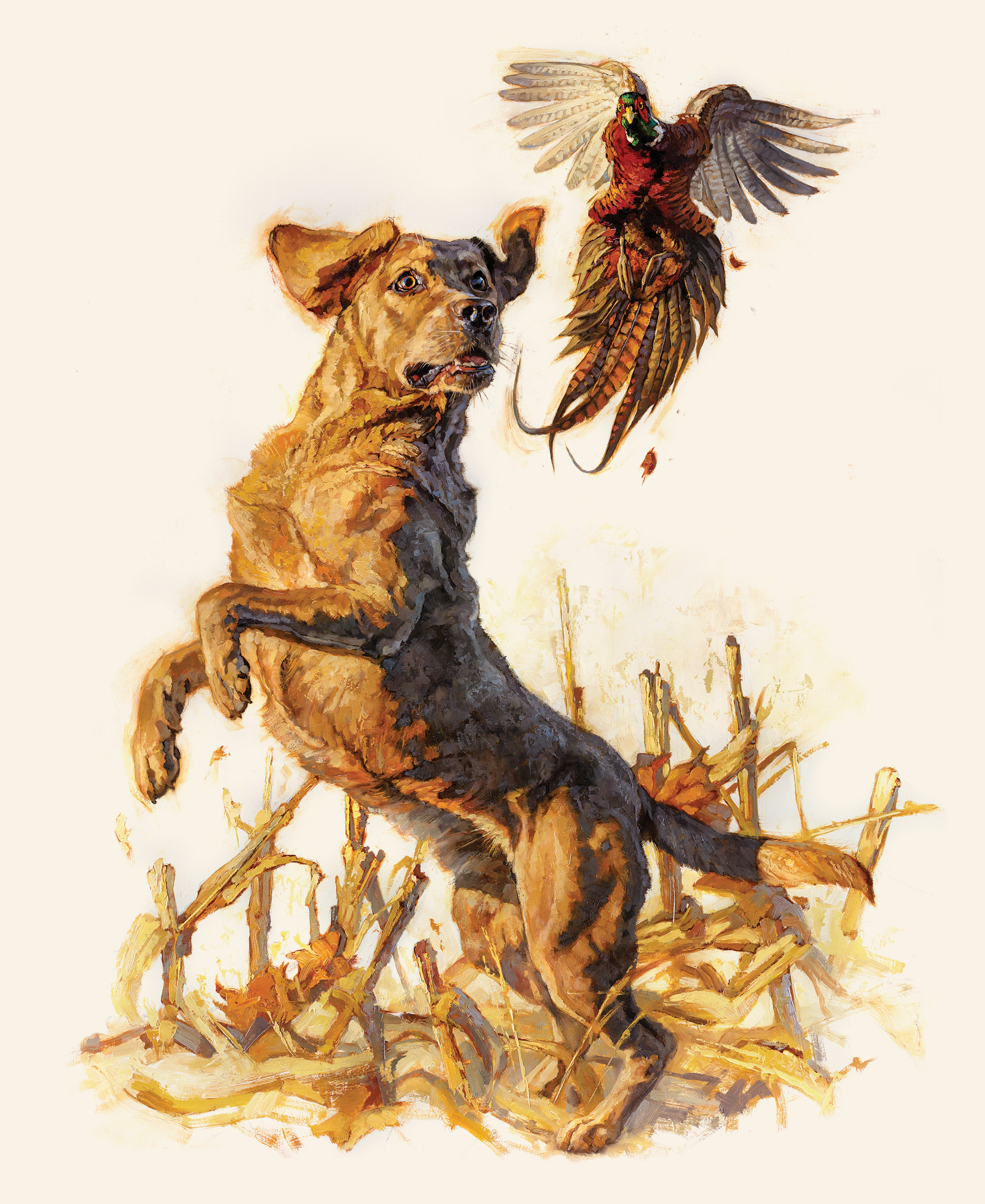
The Slough
The retriever road, a dozen years and hundreds of roosters long, ends with a final pheasant hunt in a favorite place / By Andrew McKean
We’ve been here a hundred times, you and me, hunting the old slough behind the line of rattle-branch cottonwoods. We stay away during deer season, but only partly because we both think a big old Milk River buck might show up someday and we don’t want to scare him off. The main reason is that the pheasants don’t pile into the slough until it starts getting cold, in December. After the ice freezes the black water, the roosters tuck into the cattails to keep warm and digest crops full of barley and wheat, and that’s where we find them on afternoons like this, the wind cutting through our coats and fresh tracks in the new snow.
We both know where the old roosters are holding, and we don’t have to trade looks or commands as we round the willow stand and head toward the swamp. We’re going to the same place we have hunted together a dozen times a year over a dozen seasons, and we walk side-by-side, taking our time. The long-spurred cocks are tunneled into the thickest cattails in the rotten heart of the slough, where they can hear the two of us now, crunching on the just-frozen ground.
They’re nervous, like the phalanx of twitchy hens in the orchard grass that skirts the slough, but instead of coiling to flush as we approach, the cagy old cocks resist the urge to fly and instead go lower, crouching into the murk to hide their gaudiness in a shadowy maze of standing stalks.
Their location will be betrayed, as ever, by their putrescence, and we will follow intensifying hits of tangy scent to its source. If we each do our job, the roosters will flush at the very last possible second, shattering cattails as they tower and cackle into the pewter sky. If we each do our job, the shot will be good, the retrieval uncomplicated, and by sundown another limit will be cleaned on the frosty tailgate of the old pickup.
We both know some hunts are not straightforward. Sometimes the ice isn’t good and we can’t reach the best spots. The rooster sometimes runs instead of flies, the shot sometimes is not good, and birds with ruined wings but uninjured legs sometimes get away. Those are the times we trade sideways looks at one another, silently blaming each other for the lost rooster. A disgusted glance says more than a shout or a growl ever could.
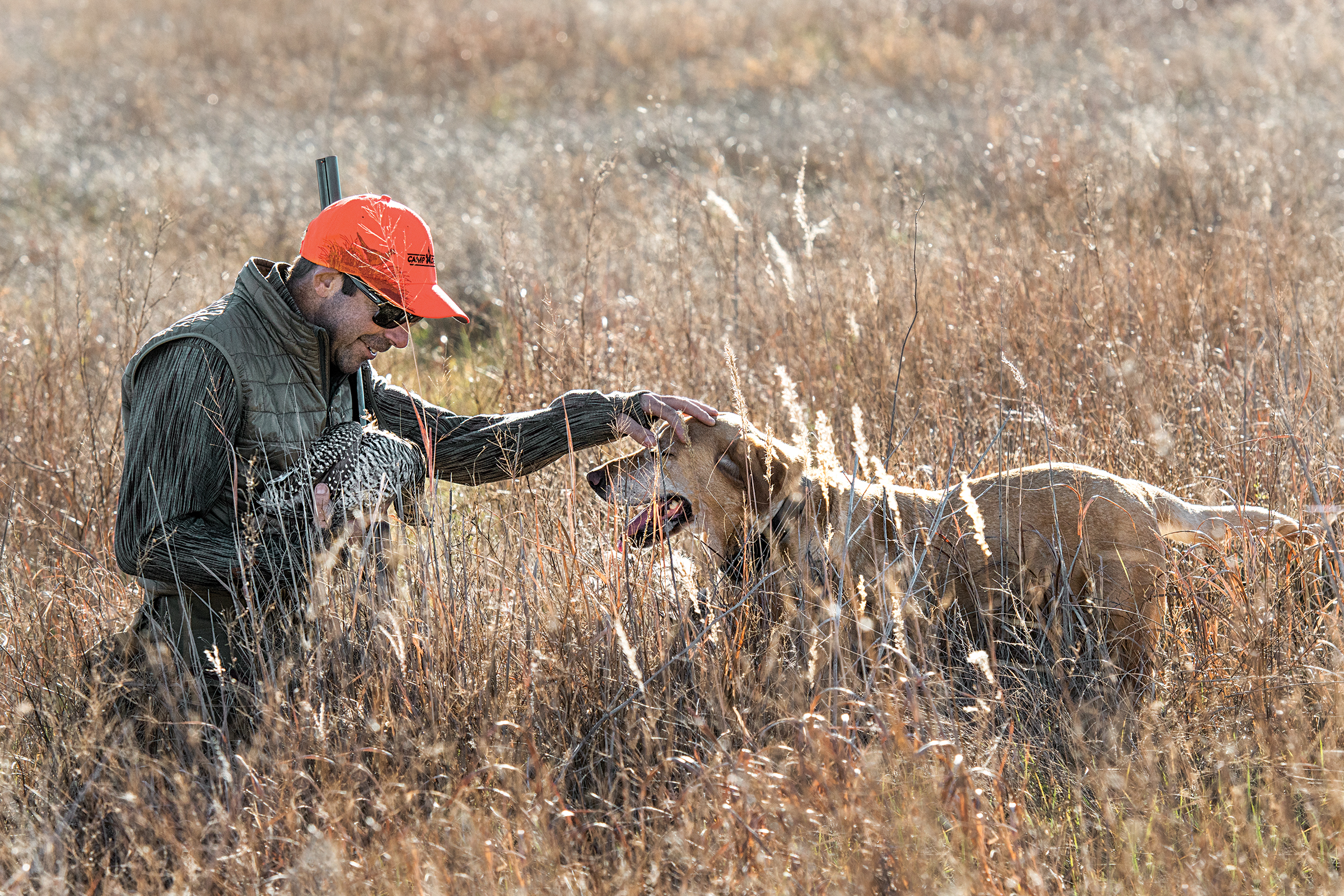
Each day we have hunted this slough over the past 12 years has been different, and today is different, too. The ice is so new that the stringy old roosters may not all be concentrated in that half acre of matted cattails. There may be some easier ones today, in the thinner cover. And today the wind is out of the east, so we circle wide in the alfalfa before entering the slough’s west edge. This never changes: We are both shivering with expectation as we stop and assess the conditions.
You don’t spend 12 years with a hunting partner and not know their abilities as well as their shortcomings. We are both smarter hunters than we once were, but we’re also stiffer and slower, expectant but cautious, a counterbalanced helix of thrill and apprehension. We are both nervous about the thickness of that ice, which is why we don’t charge right into the slough.
Retriever Roadtrip
Just three weeks ago, in South Dakota, we hunted a different, unfamiliar type of cover. Grainy milo fields and waving bluestem hid the scent of a different kind of bird. Prairie chickens look and smell like sharptails, but they flush wild like Hungarian partridges, in coveys, with one or two stragglers that hold too long, and those are the birds we carry in our mouth and game bag. The mid-November days in Dakota were different from our home in Montana, unseasonably hot and dusty, and both of us hunting at our best in the first and last hours of the day, when the scent hung like honey from the grass and the long light somehow made the shooting easier.
We camped on that trip, sharing our space with Otis and her Alex, who drove in from Minnesota. Our buddies Mark and Bill traveled with us in a motor home that had a bed in back and, up front, our bearskin rug, brought from its place in front of the fireplace at home. In Pierre, we met up with Uncle Ken and his two trip-wire Griffs, Cooper and Cider. We flushed pheasants and grouse around abandoned homesteads that smelled like cats. We slept out on the Fort Pierre National Grasslands, under the purple Dakota sky, and cooked and ate the birds that came from the prairie all around us.
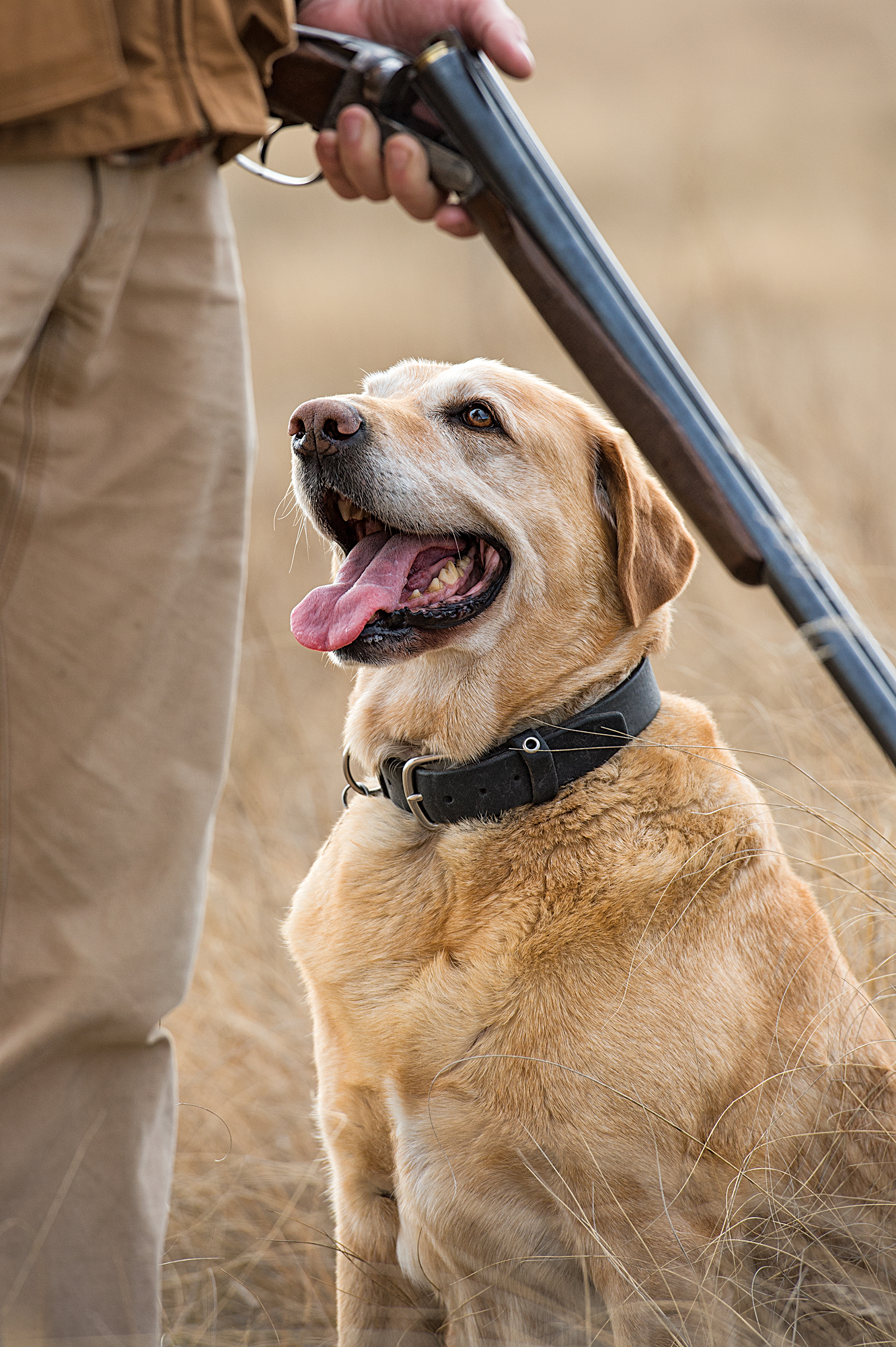
That trip was one we had promised each other for years, a week of hunting in the crucible of America’s upland country for ringnecks and grouse and maybe even ducks. Those other birds are fine, but it’s pheasants that have always quickened our blood. Maybe it’s because we live so closely with them on our place in Montana. Either of us could walk out from the house and flush at least one rooster almost any time we wanted in the brushy ditches and grassy fence lines around the fields. But we don’t. We hunt together, because a bird we team up for counts for more than one that we get on our own. A bird from the slough counts for even more, maybe because we’ve hunted here together so often that it seems like the very source of our bond. It’s where we learned each other’s talents and limitations, commands and responses, and where we’ve lain together in the cured grass, watching the autumn sky change as a limit of birds cools between us.
In Dakota, we were both younger. Maybe it was hunting new country, with new company. Or maybe it was the painkillers—ibuprofen and Rimadyl—that loosened our limbs and opened our gait. Or maybe it was playing with our younger companions during breaks for water and shade. But now, after a long day in the office and low clouds bringing another winter, both of us are creaky. So we wait on the edge of the slough, sniffing the wind and deciding whether to trust the ice.
The Flush
A bird makes the decision for us. A rooster can’t stand the gathering suspense and flushes wild.
So I go, like I always go, nose down on a hot scent that reels me into the reeds. I’m close—so close—to a bird I can almost grab with my mouth when my feet stop working. Suddenly I’m wet and cold, looking up at the sky through the spiky cattails, broken ice all around.
A rooster explodes ahead just as I break through the ice. Cold water pours over my boots, but I’m just a few feet into the slough, and I stagger backward to solid ground. I can’t see Willow in the cattails, but I hear her, snuffing, filling her nose with the heavy wet smell of a huddled rooster. Just as I realize that the ice is too thin for her, I hear her break through, too.
I hear myself whine a little. I can’t keep my head up, but maybe if I swim under the ice I’ll find him. I always find him.
I hear a feeble whine from Willow. I throw down my vest and gun, calling her name, and charge into the slough, breaking ice as I go. I’ll find her. I always find her.
When I finally find her, she’s just a couple of feet from shore, trapped under ice so thick I have to hammer it with my shotgun stock to break through. I pull her up, through the rotten cattails and icy water into the weak light, but she’s already gone. I hold her yellow head. For the first time in a dozen years together, I’m the only one who is trembling.
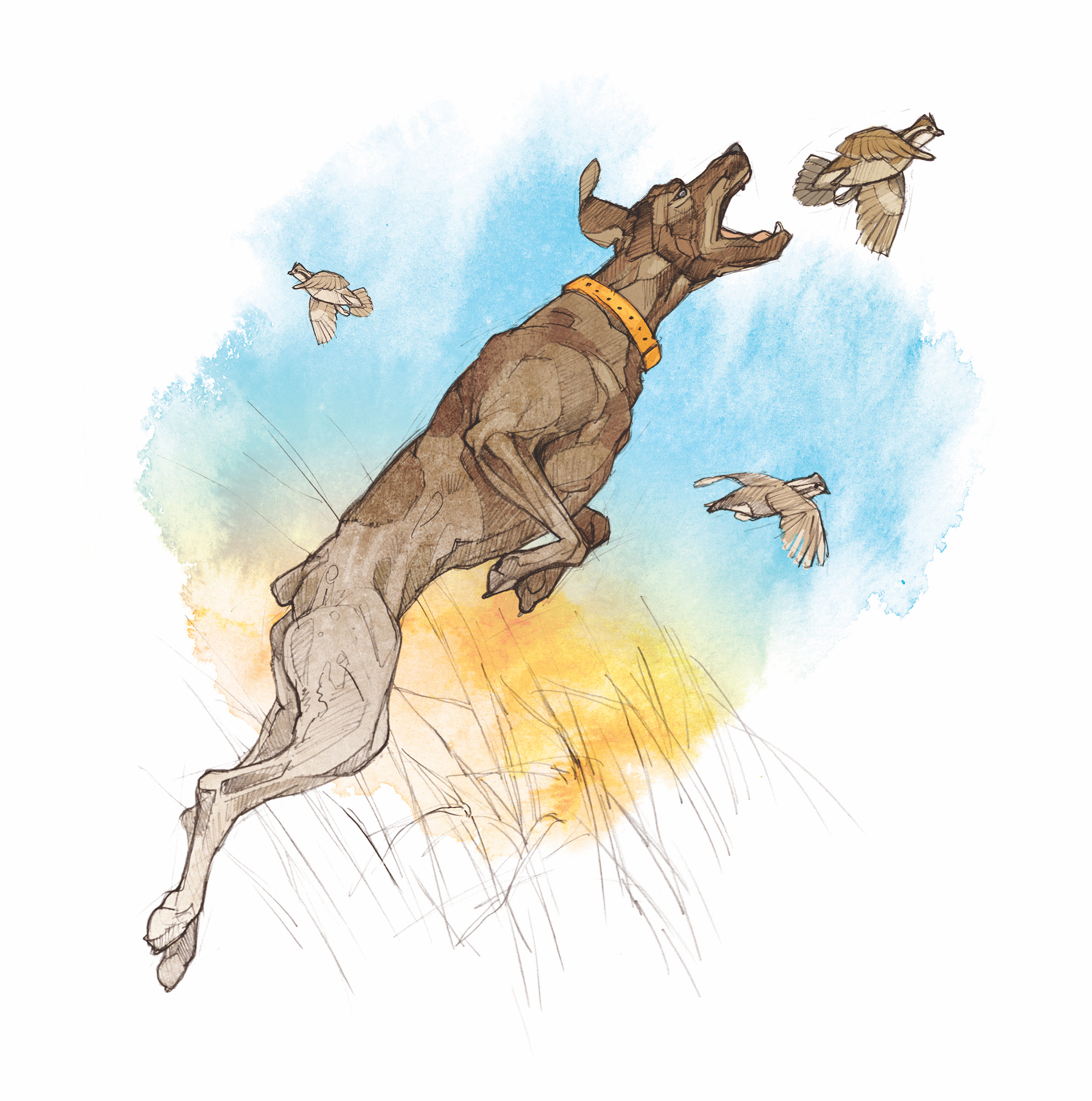
Scratch, the Unkillable
A death-defying GSP makes the ultimate comeback / By Scott Linden
Scratch hunts as if every day were his last, perhaps because he has already faced off with the Grim Reaper—twice.
The massive German shorthaired pointer weighs 75 pounds and can easily rest his head on the dining room table. His lanky, long legs are always reaching as he runs all-out, to hell with trees, briars, barbed wire, or other dogs.
Scratch’s owner, Nancy Anisfield is the polar opposite of her dog—calm, level-headed, and a careful hunter. But she lets Scratch run big. He’s a three-ring circus of trips, stumbles, cuts, and head bumps.
On his very first quail hunt, the 11-month-old Scratch was run over by a Jeep. It was one of those fancy big rigs that some quail plantations use, with platforms for hunters and boxes for the dogs. But Scratch was too big to fit in the dog box, so Anisfield had him riding up front. He slipped off the Jeep platform and fell beneath the wheel. He was degloved—the skin was peeled off his entire leg.
Scratch underwent a major surgery and five days of hospitalization. Some might argue that the surgery wasn’t worth it, and the dog should have been put down because, even if he did recover, he’d never be the same. But Anisfield never entertained that notion.
One hundred stitches and six weeks later, Scratch was in the hunt again. As soon as he was let out, he peed on a truck tire and bolted toward a scrubby patch of loblolly pine, where he came to a quivering point. Then, finding his footing, Scratch leapt skyward, flying higher than a dog should be able to, stretching for a chittering bobwhite as it flushed. In one incredible leap, muscle, bone, and heart functioned at maximum capacity. This was not the move of a finished pointing dog, but it made a bold statement: Scratch was back.
The pointer found himself in trouble again just weeks before the 2013 North American Versatile Hunting Dog Association test (a highly esteemed invitational hunt test). While retrieving a bumper, Scratch’s stomach twisted, which is usually a fatal affliction for a hunting dog. During the scramble to the vet, it un-twisted, but the vet performed a preventative surgery to avert another episode. Incredibly, three weeks later, Scratch ran the NAVHDA course, but he botched a double-mark retrieve and failed.
There are no mulligans in NAVHDA, so it was back to training for Anisfield and Scratch. Over the course of two years, Scratch pointed hundreds of birds, covered thousands of acres, and completed dozens of water retrieves. He stumbled, suffered cuts and bruises, and worked through snow and heat. The work paid off and in 2015, Scratch requalified for the big invitational.
Just 90 dogs had qualified, and typically only about half pass the test.
During the final leg of the test, Scratch churned through 80 yards of open water and made quick work of the ground search. With a bold splash, he started back with a pheasant gripped softly in his mouth. He had given it his all, but was it enough?
It was crickets as Scratch’s scores were announced. The versatile dog training circle is a small one, and most in the crowd knew what Scratch and Anisfield had been through to get this far. Then at last the scores were totaled and the crowd heaved a collective sigh of relief.
Scratch was finally a champion.
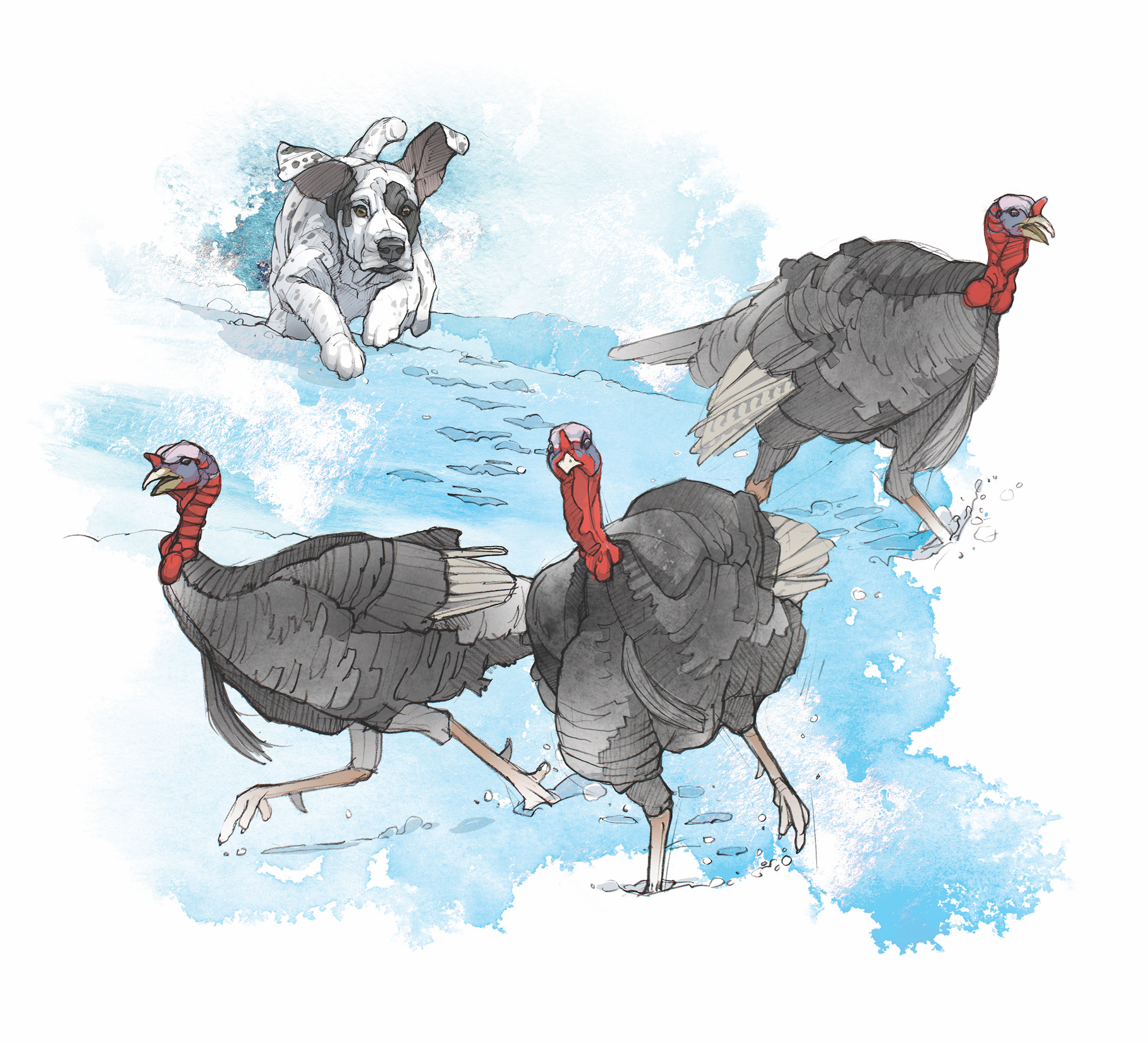
The Heart of a Turkey Dog
A pup earns his keep on his first night home / By Gerry Bethge
I entered the peculiar turkey-dog universe when a little puppy named Jake arrived via U.S. Air on a snowy January afternoon in New England.
I got the dog from renowned turkey-dog breeder John Byrne, and his last bit of training advice was this: “Just give Jake some access to turkeys. The rest will take care of itself.”
The nor’easter intensified on the ride home from the airport, and by the time I reached hunting camp, more than 6 inches of snow had fallen atop the foot we already had. While my 10-week-old pup chased my giggling 3-year-old daughter, Amy, around the kitchen, I busied myself with the woodstove.
Then, I got a gift from the turkey gods.
Through the thick condensation of the front-door glass, I could make out three dark forms walking down the driveway toward the house. I wiped away the fog to see three adult gobblers standing just 20 feet away in the blowing snow. Not expecting much, I picked up Jake and headed out into the storm. By the time I got out the front door, the toms had gained 50 yards on us and were at the wood line. Jake hit the ground running, though it was more hopping between chest-deep snowdrift plunges. Puppy legs churning away, he followed the tracks precisely, first to the wood line, and then on up the hill directly behind the now-out-of-sight gobblers. I foundered in the snow, too, with admittedly more quit than Jake. I called off the chase after 300 yards. I didn’t want to lose this puppy after only a few hours of owning him.
Soaked and shivering, Jake was a mess. So I tucked my new little turkey dog into my coat and headed back to camp, already thinking ahead to fall.
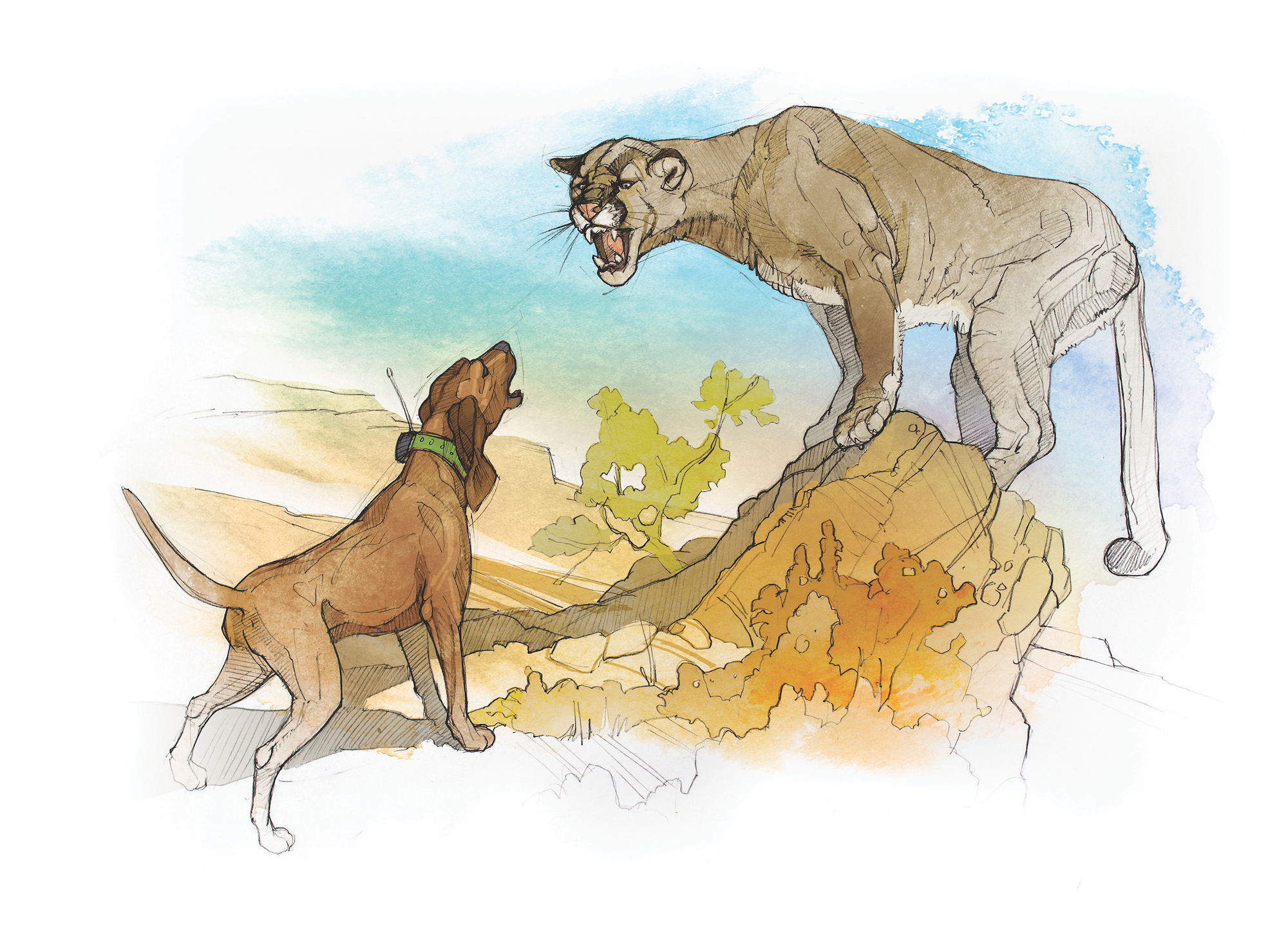
Lacey and the Lion
A rookie redtick goes head-to-head with a monster mountain lion / By Brad Fitzpatrick
Dry-land mountain-lion hunting requires a special hound—a dog with stamina, a good nose, and, most important, a drive that will carry her over rough terrain behind a trail of evaporating scent.
The Uncompahgre Plateau of western Colorado, where Cliff Carney guides lion hunts, is a landscape that will test even the most experienced lion dog. It consists of rimrock canyons, cedar forests, and rocky draws. It’s tough country, and it’s where Carney’s one-year-old redtick pup Lacey would get her first test.
Lacey showed promise early on. She was eager to learn and easy to handle, and she developed a strong bond with Carney. So, naturally, he wanted to get her on a hunt and have her learn from his veteran dogs.
Lacey and the rest of Carney’s pack (a mix of blueticks and bluetick-Walker crosses) struck the trail of a mature tom during Colorado’s spring season. Judging by the size of the lion’s paw print, Carney and his best friend, Shawn Tyner, had a good idea they were on a very big tom. The dogs ran behind the cat all day, crossing broken scrabble and sheer rock. By late afternoon, the hounds were exhausted, so Carney called off the chase for the day.
Just after dawn the next morning, they picked up the track again. Lacey sat out this hunt because Carney didn’t want to put too much pressure on his promising young dog. Again, the dry air and heat were too much for the fatigued hounds, and Carney made the call to abandon the hunt.
By the third day, the dogs were rested but not at full capacity, except for Lacey. But Carney and Tyner decided to try once more, and they headed for the roughest strip of country in the area.
A flock of crows alerted Carney to a dead cow elk. Not far from the kill, they cut a cat’s track, and they suspected that it was the big tom they were chasing. The hunt was back on.
Throughout the morning, Carney watched on his GPS tracker as his dogs dropped from the race. First was his hound Jet, who became trapped on a ledge and needed to be rescued. Then his old, experienced hounds, Sam and Stoker, slowed and dropped from the hunt. Before long, only a single blip on his GPS was still pushing the trail. It was the redtick pup Lacey. She was running the lion solo.
This was a problem. If Lacey managed to catch the lion by herself, she’d likely be killed. A pack of hounds can keep a lion at bay with relatively little risk. But a single dog, especially an inexperienced pup like Lacey, was an easy mark for a big tom. As the signal from her collar traced a path directly through the roughest canyon country in the Uncompahgre, the hunters set out at a lung-bursting pace.
They followed Lacey through big canyons, the sound of her raspy bawls echoing against the rimrock. Finally, the two hunters followed the GPS signal up a ridge to a narrow ledge that dropped 300 feet to the canyon floor below. There at the edge stood Lacey, eye-to-eye with a furious tom.
The older dogs, Stoker and Sam, caught up then, and the three hounds stood shoulder-to-shoulder in front of the cat, their howls booming off the rock walls. Tyner quickly killed the lion, bringing the three-day chase to an end. The massive tom weighed almost 200 pounds.
But for Carney—a lifelong houndsman—there was something much more rewarding than a trophy cat at the end of the track. When he cut Lacey loose, she was a promising but untested pup. Now she was a true lion hunter.
This story, Wonder Dogs, originally ran in the August 2017 issue. Read more OL+ stories.
